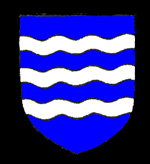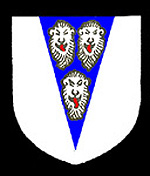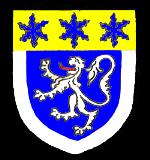The Manor of Milton Bryan
Volume III of The Victoria County History for Bedfordshire was published in 1912. It contains histories of the various manors in Milton Bryan. The main manor, tracing its history back to the housecarl Auti’s holding in 1066 was held by the Beauchamp family as overlords until 1266 when John de Beauchamp was killed fighting against King Henry III (1216-1272) at the Battle of Evesham. The Beauchamp lands were then divided between John’s three sisters.
The overlordship of Milton Bryan Manor passed to Maud Beauchamp who married Roger de Moubray. After the death of Roger de Moubray, Maud married Sir Robert Lestrange who died in 1312. Maud's heir was her grandson from her first marriage, John de Moubray. He joined the rebellion of Earl Thomas of Lancaster against King Edward II (1307-1327) in 1321 and was captured at Earl Thomas' defeat at the Battle of Boroughbridge; he was soon afterwards hanged as a traitor at York. Edward II's favourite and, possible lover, Hugh le Despenser was, inevitably, granted de Moubray's former manors in the same year. Despenser was executed for treason in 1326 and all his estates reverted to the Crown. On Edward II's murder in 1327 the overlordship reverted to the de Moubray family and to John's son, another John. The overlordship is last mentioned in 1470.
The overlord of a manor leased that manor out to a tenant. The first of these we know of is William Froissart, mentioned in the Domesday Book. No trace of his heirs can be found and in the second half of the 12th century, a hundred years or so after Domesday, the tenancy of the manor was in the hands of the Bryan family, whose name was attached to the old name of Milton in order to distinguish it from the Beauchamps’ other Bedfordshire Milton possession – Milton Ernest. The Bryans remained as tenants until 1344 when John Bryan alienated the manor to Woburn Abbey.

Coat of arms of Woburn Abbey
When Woburn Abbey was dissolved in 1538 Milton Bryan Manor was taken by the Crown and, in 1542, was annexed to the newly created Honour of Ampthill. In 1599 Queen Elizabeth I (1558-1603) granted the manor to Michael and Edward Stanhope. Two years later Michael Stanhope sold the manor to Christopher Estwick, who settled it on his wife Ann and their children in 1606. Christopher died in 1611 and his son, of the same name, sold the manor to Sir Francis Staunton in 1626. About 1655 Staunton’s grandson sold the manor to William Johnson and it was probably one of this family who built the manor house.

The Johnson family coat of arms
William Johnson was succeeded by his son Thomas. He was High Sheriff of the county in 1702 and 1703 and died in 1707. His son Joseph was also High Sheriff, in 1726 and died in 1742 without heirs. He willed the manor to his third cousin Henry Johnson. On his death in 1771 he left the manor to his daughter Catherine.

The Inglis family coat of arms
Catherine married Sir Hugh Inglis in 1784 and he took possession of it after her death in 1792. He was a director of the East India Company and was made a baronet in 1801. He died in 1820. His son Robert was Member of Parliament for for Dundalk 1824-1826, Ripon 1828-1829 and Oxford University from 1829 to 1854. He was appointed High Sheriff of Bedfordshire in 1824. He died without issue in 1855, leaving the manor to his widow who, in turn, devised it in her will to a Miss Thornton. In 1898 the Lady of the Manor was Miss Henrietta L. Synnot and she sold it to the Duke of Bedford in 1906. A succession of Law of Property Acts in the 1920s extinguished all manorial incidents, courts and copyhold tenure of land. This effectively abolished manors in all but name.